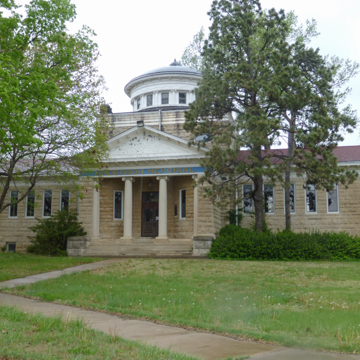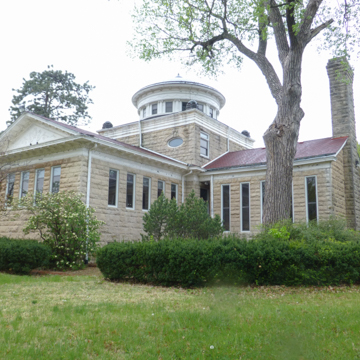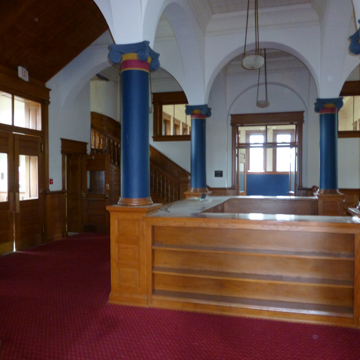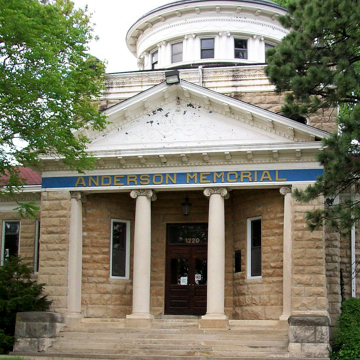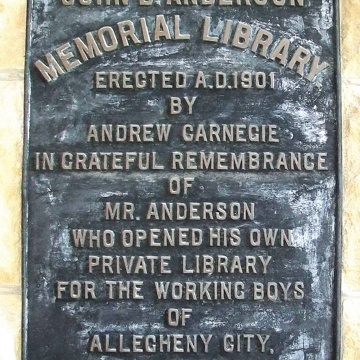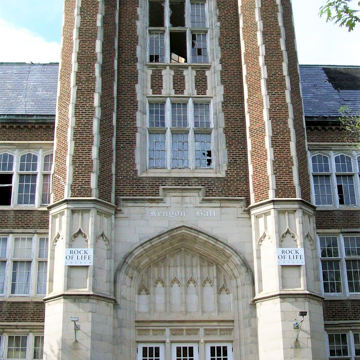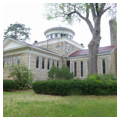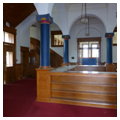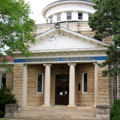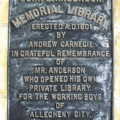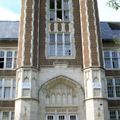The Anderson Memorial Library is a very special case of what would become a common building type in Kansas. One of sixty-six Kansas libraries to be financed by grants from the Andrew Carnegie Foundation, it was the only one whose application for support was actively solicited by the Foundation, and the first given to an institution of higher education. The building is, in many ways, an exemplar of the kinds of facilities recommended in the 1910 design guidelines for the Carnegie Corporation Library Building Program. It may well have been a referent or a prototype for this document. But the building is more than simply a highly serviceable library; it is also a monument to Colonel John Anderson, the man who inspired Andrew Carnegie’s philanthropy.
The library was built as the centerpiece of the campus of the College of Emporia, a private institution affiliated with the Presbyterian Church. The College was founded in 1884, and was located on spacious grounds in the northwestern corner of Emporia. As an acquaintance of the college’s first president, Reverend John F. Hendy, and a Presbyterian himself, Carnegie was anxious build the monument to his boyhood hero at the College of Emporia. In his autobiography, Carnegie credited the furthering of his education to Anderson, a wealthy iron maker who opened his extensive personal library on Saturdays to young working men of the neighborhood. Between 1886 and 1929, the Carnegie Foundation worked to repay Anderson’s kindness by helping to fund over 2,500 libraries around the world.
Although the Carnegie Foundation did not issue design guidelines for the buildings it financed until ten years after the Anderson Library was commissioned, the Anderson Library conformed to these later dictates. Designed by Emporia architect Charles W. Squires, the one- and two-story rusticated limestone building rests on a raised foundation. The main entry portico is in the central, protruding pavilion. While the library displays similar characteristics to those in the guidelines, it also includes some unique features such as a second-floor reading room located above the central bay, which is accessible by stairs on either side of the main entry portico. The upper level reading room supports a round drum ringed with windows that are capped by a gently curved dome. A large skylight in the dome illuminates the reading room below. The rough-cut, locally quarried limestone walls also made the building unique; these walls are complemented by refined details including the well-proportioned Ionic columns at the entry and around the drum, and by pressed metal panels around the eaves of the dome and in the pediment above the main entry.
The building’s unique spaces and special features made it a fitting tribute to Anderson’s generosity. These elements also illustrate the skill of Squires, whose designs were often more eclectic in nature. The building demonstrates his ability in executing a more restrained and stylistically coherent structure, while still reflecting the architect’s unique vision. It was a much loved building, as can be seen on the interior of the drum and dome, which bears the signatures of all of the graduates of Emporia College.
Like other Carnegie libraries, the Anderson Library was forced to respond to changing circumstances. Emporia College closed in 1974 and the campus was taken over by another religious group and operated as Way University. In the 1970s and 1980s, the building was remodeled to support changing uses, particularly in the basement. Unlike the many Carnegie libraries in Kansas, this building remains largely intact, but its future is uncertain. When Way University closed, the campus was sold off in pieces. Private individuals purchased the library and gave it to Emporia State University, a public institution (formerly the Kansas Normal School or Teacher’s College). The University maintained the structure, but was never able to find a suitable use for the building, which is located several miles west of the main campus. In early 2015, the building was again sold to individuals from Emporia, who are determined to find an appropriate use for the old library.
NOTE: This entry was originally published in David Sachs and George Ehrlich, Guide to Kansas Architecture (Lawrence: University Press of Kansas, 1996). © 1996 by the University Press of Kansas.
References
Bertram, James. Notes on a Library Building. New York: Carnegie Corporation, 1910.
Hagedorn, Martha Gray, “Anderson Memorial (Carnegie) Library,” Lyon County, Kansas. National Register of Historic Places Inventory–Nomination Form, 1987. National Park Service, U.S. Department of the Interior, Washington, D.C.
Hagedorn, Martha Gray, “Carnegie Libraries of Kansas,” Kansas. National Register of Historic Places Inventory–Nomination Form, 1987. National Park Service, U.S. Department of the Interior, Washington, D.C.
Murphy, Jesse. “New owners making efforts to save Anderson Memorial Library.” Emporia Gazette,January 31, 2015.

